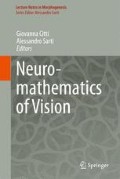Abstract
Shape from shading is a classical inverse problem in computer vision. It is inherently ill-defined and, in different formulations, it depends on the assumed light source direction. In contrast to these mathematical difficulties, we introduce a novel mathematical formulation for calculating local surface shape based on covariant derivatives of the shading flow field, rather than the customary integral minimization or P.D.E approaches.Working with the shading flow field rather than the original image intensities is important to both neurogeometry and neurophysiology. To make the calculations concrete we assume a Lambertian model for image formation, butwe do not make global light source positional assumptions. In particular, for smooth surfaces in generic position, we show that second derivatives of brightness are independent of the light sources and can be directly related to surface properties. We use these measurements to define the matching local family of surfaces that could result from a given shading patch. In total our results change the emphasis from seeking a single, well-define solution to an ill-posed problem to characterizing the ambiguity in possible solutions to this problem. The result is relevant both mathematically and perceptually, because we then show how the equations simplify and the ambiguity reduces are certain critical points of intensity. We conclude with a discussion of image reconstruction at these critical points.
This work was supported by the National Science Foundation.
Access this chapter
Tax calculation will be finalised at checkout
Purchases are for personal use only
Preview
Unable to display preview. Download preview PDF.
References
Barron, J., Malik, J.: Shape, illumnation, and reflectance from shading. Technical Report (2013)
Breton, P., Zucker, S.W.: Shadows and Shading Flow Fields. In: Proc. IEEE Conf. on Computer Vision and Pattern Recognition, CVPR 1996, pp. 782–789 (1996)
Cole, F., Sanik, K., DeCarlo, D., Finkelstein, A., Funkhouser, T., Rusinkiewicz, S., Singh, M.: How well do line drawings depict shape? ACM Trans. Graph. 28 (2009)
DeCarlo, D., Finkelstein, A., Rusinkiewicz, S., Santella, A.: Suggestive contours for conveying shape. SIGGRAPH, 848–855 (2003)
D’Errico, J.: Interpolating elements in a 2d array. Matlab Central File Exchange (2004)
Docarmo, M.P.: Differential Geometry of Curves and Surfaces. Prentice-Hall Inc., Upper Saddle River (1976)
Dodson, C.T.J., Potson, T.: Tensor Geometry. Springer, Heidelberg (1991)
Fleming, R., Holtmann-Rice, D., Bulthoff, H.: Estimation of 3D Shape from Image Orientations. Proceedings of the National Academy of Sciences 108 (2011)
Fleming, R., Torralba, A., Edelson, E.: Specular reflections and the perception of shape. Journal of Vision 4 (2004)
Fleming, R., Vergne, R., Zucker, S.W.: Predicting the effects of illumination in shape from shading. Journal of Vision 13 (2013)
Freeman, W.T.: The generic viewpoint assumption in a framework for visual perception. Nature 368, 542–545 (1994)
Garding, J.: Surface orientation and curvature from differential texture distortion. In: Proc. 5th International Conference on Computer Vision (1995)
Hubel, D.: Eye, Brain, and Vision. Scientific American Library (1988)
Hummel, R., Zucker, S.: On the Foundations of Relaxation Labeling Precesses. IEEE Transactions on Pattern Analysis and Machine Intelligence, PAMI-5 (1983)
Judd, T., Durand, F., Adelson, E.H.: Apparent ridges for line drawing. ACM Trans. Graph. 26, 19 (2007)
Koenderink, J.J.: What does the Occluding Contour tell us about Solid Shape? Perception 13, 321–330 (1984)
Koenderink, J.J.: Solid Shape. The MIT Press, Cambridge (1990)
Koenderink, J.J., Van Doorn, A.J.: Photometric invariants related to solid shape. Optica Acta 27, 981–996 (1980)
Koenderink, J.J., Van Doorn, A.J., Kappers, A.M.L.: Ambiguity and the ’mental eye’ in pictorial relief. Optica Acta 30, 431–448 (2001)
Koenderink, J.J., van Doorn, A.J.: Illuminance critical points on generic smooth surfaces. J. Opt. Soc. Am. A 10 (1993)
Koenderink, J.J., van Doorn, A.J.: Two-plus-one-dimensional differential geometry. Pattern Recognition Letters 15, 439–443 (1994)
Koenderink, J.J., van Doorn, A.J., Wagemans, J.: Sfs? not likely! i-Perception 4, 299–302 (2013)
Kunsberg, B., Zucker, S.W.: Shape-from-shading and cortical computation: a new formulation. Journal of Vision 12 (2012)
Kunsberg, B., Zucker, S.W.: Characterizing ambiguity in light source invariant shape from shading. SIAM Journal of Imaging Sciences (2013) (submitted)
Mach, E.: On the Physiological Effect of Spatially Distributed Light Stimuli (Transl, F. Ratliff). In: Mach Bands: Quantitative Studies on Neural Networks in the Retina. Holden Day, San Francisco (1965)
Pentland, A.: Local Shading Analysis. IEEE Transactions on Pattern Analysis and Machine Intelligence, PAMI-6 (1984)
Ramachandran, V.S.: Perceiving shape from shading. Scientific American 259, 76–83 (1988)
Wagemans, J., Van Doorn, A.J., Koenderink, J.J.: The shading cue in context. i-Perception 1, 159–178 (2010)
Yamane, Y., Carlson, E.T., Bowman, K.C., Wang, Z., Connor, C.E.: A Neural Code for Three-Dimensional Object Shape in Macaque Inferotemporal Cortex. Nature Neuroscience: Published Online (2008)
Author information
Authors and Affiliations
Corresponding author
Editor information
Editors and Affiliations
Rights and permissions
Copyright information
© 2014 Springer-Verlag Berlin Heidelberg
About this chapter
Cite this chapter
Kunsberg, B., Zucker, S.W. (2014). Why Shading Matters along Contours. In: Citti, G., Sarti, A. (eds) Neuromathematics of Vision. Lecture Notes in Morphogenesis. Springer, Berlin, Heidelberg. https://doi.org/10.1007/978-3-642-34444-2_3
Download citation
DOI: https://doi.org/10.1007/978-3-642-34444-2_3
Publisher Name: Springer, Berlin, Heidelberg
Print ISBN: 978-3-642-34443-5
Online ISBN: 978-3-642-34444-2
eBook Packages: Mathematics and StatisticsMathematics and Statistics (R0)

